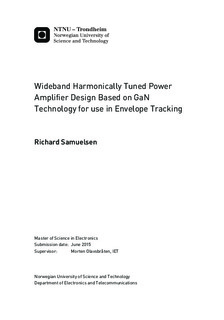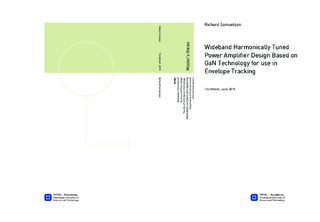| dc.description.abstract | In this thesis, the design, simulation and measurements of a harmonically tuned 10 W
wideband high efficiency power amplifier employing envelope tracking is presented. The
simulations and design were carried out with the use of the CAD tool Keysight ADS. The
optimal impedances for f0, 2f0 and 3f0 were mapped for both source and load with the
help of the load pull technique, and matching networks were designed to try to model the
optimal impedances. The matching networks consists of microstrip transmission lines and
passive components. Simulations of the design with lossy components showed an average peak power added efficiency (PAE) of 67% from 1.8 GHz to 2.6 GHz while maintaining 40 dBm (10 W) output power. The final realized design was measured to deliver an average peak PAE of 66% from 1.8 GHz to 2.6 GHz while maintaining 40 dBm output power. The highest measured output was 41.8 dBm (15.1 W) at 1.8 GHz. For the small signal performance the gain was measured to be a maximum of 18.2 dB at 2.4 GHz and maintain 12 dB gain from 1.1 GHz to 2.65 GHz. A 3 dB bandwidth of 1.05 GHz, from 1.55 GHz to 2.6 GHz, was measured for the small signal gain. The input match (S11) requirement in the specifications was not fulfilled as this proved to be extremely hard, if not impossible while still fulfilling the rest of the specifications. A solution to reduce S11 is proposed at the cost of less gain and efficiency. Microwave power amplifiers obtain maximum efficiency when operating close to the saturation point. For fixed bias amplifiers the saturation point is close to the maximum output power of the device. The saturation point is dependent on the supply voltage for the amplifier and by modulating the supply voltage high efficiency can be achieved for lower output power levels. Two schemes are used in this thesis to modulate the supply voltage, namely envelope tracking and power tracking. The strengths, weaknesses and the increase in efficiency are explored for the two methods for both two tone and 16-QAM signals. Two tone baseline measurements were taken at 1.8 GHz, 2.2 GHz and 2.6 GHz with a fixed supply voltage while the PA was close to 1 dB compression. This resulted in a PAE of 53%, 52% and 47%. Employing the tracking schemes to the amplifier resulted in a PAE of 63%, 59% and 53% for envelope tracking and 60%, 59% and 51% for power tracking. A 16-QAM
baseline was established and resulted in 37%, 22% and 30% for the same frequencies as
the two tone test. With the use of envelope tracking the PA was measured to have a PAE
of 53%, 39% and 47%. The power tracking scheme resulted in a PAE of 48%, 32% and
39%. The measurements for the tracking schemes shows that the techniques are viable for
complex modulation schemes with the use of linearization techniques. | |

